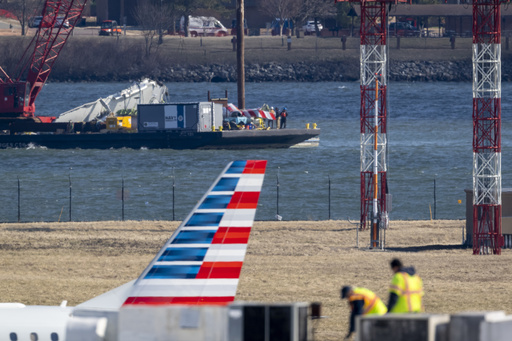Concerns regarding aviation safety have been spurred by a succession of serious incidents and near-misses.
Recent high-profile tragedies such as a midair collision near Washington that resulted in the loss of 67 lives, a harrowing plane crash in Philadelphia, and the disappearance of a plane in Alaska have raised alarms.
Additionally, incidents like a Japan Airlines flight clipping a parked Delta airplane while taxiing in Seattle and a United Airlines plane igniting during takeoff in Houston due to engine issues have heightened fears.
Security anxieties are also on the rise following the discovery of stowaways who perished in the wheel wells of multiple aircraft.
Moreover, a passenger’s decision to open an emergency exit door during taxi in Boston further complicated the public’s faith in flight safety.
Given these events, many travelers are left questioning the safety of their upcoming flights.
In examining the most disturbing occurrences, the recent midair collision on January 29 between an American Airlines jet and an Army helicopter stands out due to its tragic outcome, with all passengers aboard both aircraft lost.
It marked the worst aviation disaster in the United States since November 2001, when a New York City tragedy claimed 260 lives on board a jet and five more on the ground, and prior to that, no fatal incidents involving U.S. airlines had occurred since February 2009.
While crashes involving larger commercial airlines are infrequent, smaller aircraft, such as a single-engine Cessna that went missing in Alaska with ten on board, often encounter more incidents.
A medical transport jet crash on January 31 in Philadelphia also contributed to the distress, with six fatalities on board and one on the ground, prompting a fireball upon impact shortly after takeoff.
The rarity of fatal crashes often garners significant media attention, even though U.S. airlines maintain a commendable safety record.
For context, data reveals that fatal crashes are less frequent, with some notable incidents globally, including a disaster in South Korea that killed all 179 on a flight in December, along with two deadly occurrences involving the Boeing 737 Max in 2018 and 2019.
An alarming incident last January involved a door plug blowing off a 737 Max in flight, prompting further scrutiny of the aircraft’s safety.
Federal authorities have been voicing concerns regarding an overstretched and understaffed air traffic control system for years, particularly after multiple close calls at U.S. airports.
Issues leading to these staffing shortages include inadequate salaries, demanding work hours, intensive training, and stringent retirement mandates.
Adding to the unease, former President Donald Trump attributed the midair collision to the outdated air traffic control system and vowed to implement reforms.
Notwithstanding these concerns, Transportation Secretary Sean Duffy sought to reassure the public on a recent Fox News appearance, declaring that air travel remains significantly safer than car or train journeys and emphasizing its status as the safest transportation method.
Statistical data supports this assertion; according to the National Safety Council, Americans face a 1 in 93 chance of dying in a vehicle crash, while the probability of airplane fatalities is exceedingly low.
Data from the U.S. Department of Transportation echoes this sentiment, bolstering confidence in flight safety.
In the wake of these troubling incidents, both the National Transportation Safety Board and the Federal Aviation Administration have embarked on comprehensive investigations to identify the causes and promote measures to avert future tragedies.
Preliminary revelations have already emerged from investigations surrounding the midair collision, with a comprehensive report expected to take over a year to finalize.
The NTSB routinely advocates for preventive measures related to aviation safety; however, a considerable number of their earlier recommendations have languished, often ignored by relevant government bodies and industry stakeholders.
Duffy acknowledged public concern regarding aviation safety and asserted that measures must be taken to ensure that such accidents remain unacceptable.
He pledged to prioritizing safety as he steers the agency responsible for overseeing various transportation modes, claiming optimism in the existing safety framework and future enhancements aimed at improving overall system efficacy.



